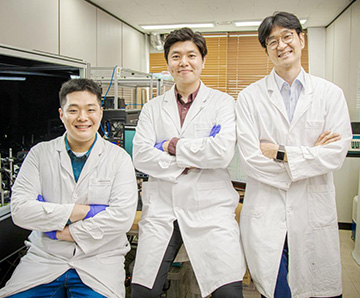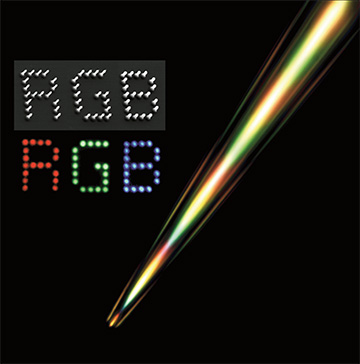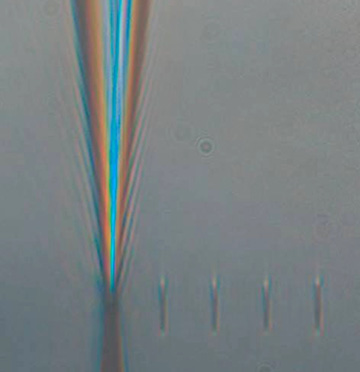A 3D-printing method devised by researchers in Korea and Hong Kong builds up nanoscale pixels of red, green and blue colors by using a glass “nanopipet” to deposit pillars of polystyrene ink doped with quantum dots. The team believes that the nanopillars, only 620 nm in diameter and 2 to 10 µm in height, can be packed together to achieve display resolutions more than five times greater than those achievable with current commercial technology. [Image: Courtesy of J. Pyo] [Enlarge image]
Display resolutions have improved incredibly in recent years—so much so that some wonder whether the newest generation of high-definition TVs, so-called 8K displays, has reached the limits of resolution enhancement that the human eye can distinguish (see “Television Goes 8K,” OPN, May 2020). But for some applications, such as microprojection and augmented and virtual reality (AR/VR), researchers continue to chase ever-smaller pixel sizes and higher pixel densities. And these efforts eventually run up against some practical limitations, particularly on pixel brightness, that are imposed by the 2D-patterning approaches commonly used to create display pixels.
Now, researchers from the Republic of Korea and Hong Kong have proposed a novel 3D-printing approach to manufacturing pixels for display—one, they maintain, that could allow much smaller, nanoscale pixels to be crowded in at far higher densities than is possible with 2D-patterning methods (ACS Nano, doi: 10.1021/acsnano.0c04075). The team’s approach rests on building up pixels vertically on free-standing nanopillars of a polymer that’s been spiked with luminescent nanoparticles, also known as quantum dots (QDs).
The 3D-printing process, the research team reports, can produce 620-nm-wide pixels of pure color that are twice as bright as those made from 2D patterning. And the researchers claim that the method can lay down these nanoscale pixels at a “super-high density” some five times higher than limits of current commercial technology—a characteristic that could give the method potential not only in display technology but also in some niches in data storage, cryptography and other applications.
Brightness limitations
In addition to photolithography, common 2D methods for printing display pixels include inkjet and electrohydrodynamic-jet (e-jet) printing and transfer printing. These methods lay the light-emitting material down in a programmable pattern on a film layer that’s then used to build the display or other technology.
The problem with these methods is that, the smaller the pixel gets, the less light-emitting material it can contain—and, thus, the dimmer it will be. The brightness can be pumped up somewhat by repeating the printing process to vertically thicken the pixel; however, this tends to smear out the pixel laterally in practice, reducing the achievable resolution.
A 3D-printing approach
To try out a different approach, the team behind the recently published research—led by Jaeyeon Pyo and Seung Kwon Seol of the Korea Electrotechnology Research Institute (KERI)—adapted a 3D-nanoprinting method that the researchers had developed four years earlier for fabricating nanophotonic waveguides.
The team began by selecting QDs, noted for high quantum efficiency and long-term stability, as the luminescent agents to be used in the pixels. The researchers then doped samples of a polystyrene polymer solution with these luminescent nanoparticles, creating three different polymer inks, each with dots emitting at a different wavelength—650 nm (red), 540 nm (green) or 480 nm (blue).
The quantum-dot-doped “nanopillars” are deposited by a glass pipette with a nozzle around 630 nm in diameter, which builds up each nanopillar before moving to the next, as shown in a video from the research team. [Image: Courtesy of J. Pyo] [Play video]
Next, the team got down to the business of manufacturing pixels with these QD-doped inks. To do so, they used a tapered glass “nanopipet,” with an opening diameter of only around 630 nm, to squirt out femtoliter quantities of the ink. As it moves upward away from the substrate, the nozzle builds up a pillar of polymer, around 620 nm in diameter and 2 to 10 µm in height, that rapidly cures in air.
At the end of the run to build each pixel, the pipette is suddenly yanked upward to terminate the nanopillar. A motorized stage then adjusts the substrate position and the process is repeated to build the next red, green or blue pixel. (A video provided by the researchers shows the nanofabrication process in action.)
Bright and controllable
The result of the 3D-printing process is an array of slender, free-standing vertical polymer nanowires, each packed with quantum dots that emit light at a different color when stimulated by light or electricity.
A variety of tests of the pixel emissions showed, not surprisingly, that the higher the pillar, the brighter the pixel. The tests also showed, however, that building the nanowires higher did not significantly affect the spot size of the pixel—suggesting that the approach offers the prospect of significantly brightening these tiny pixels, without sacrificing resolution. (Another way of pumping up the pixel brightness, the team found, was by simply increasing the density of quantum dots in the polymer solution.)
The researchers also tested out the pixels in a triangular “delta-type” pixel array, with the triangle consisting of one red-, green- and blue-emitting nanopillars as sub-pixels. By selectively tickling the sub-pixels with laser light, the team was able to nudge the QDs into emitting other apparent colors by mixing of the red, green and blue components.
Fivefold resolution increase?

First author Jongcheon Bae, left, with team leaders Jaeyeon Pyo (middle) and Seung Kwon Seol (right). [Image: Korea Electrotechnology Research Institute (KERI)]
The team says its method can produce pixels twice as bright as with conventional thin-film-based methods, “with a lateral dimension of 620 nm and a pitch of 3 µm for each of the red, green and blue colors.” When laid out as subpixels in the delta-type geometry, the researchers say, the nanopillar emitters allow for a resolution of as high as 5600 pixels per inch (ppi). That is, according to a press release accompanying the research, more than five times the 1000-ppi limit of current commercial technology.
At those resolutions, the team believes that the method could find use in future super-high-resolution displays, particularly for “nanodisplay”-type applications in microprojection and AR/VR, as well as certain types of wearable technology. But the researchers see some other intriguing applications as well—for example, in certain anti-forgery, information storage and cryptography applications. Getting to any of these on a commercial basis, the team acknowledges, will require “additional efforts” to scale up the femtoliter-nozzle system for manufacturing.


